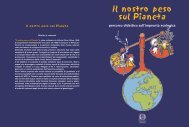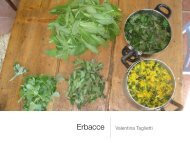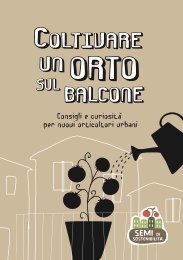Myanmar Protected Areas: Context, Current Status ... - Istituto Oikos
Myanmar Protected Areas: Context, Current Status ... - Istituto Oikos
Myanmar Protected Areas: Context, Current Status ... - Istituto Oikos
Create successful ePaper yourself
Turn your PDF publications into a flip-book with our unique Google optimized e-Paper software.
ALAUNGDAW KATHAPA<br />
Site ID 1<br />
Locality Sagaing Region, Kani and Mingin Townships<br />
Coordinates N22° 23’, E94°25’<br />
Size (km²) 1597<br />
Altitude (m. asl) 135-1335<br />
<strong>Myanmar</strong> category National Park<br />
IUCN category II<br />
Site Governance Nature and Wildlife Conservation Division<br />
Boundaries Demarcated<br />
Year gazetted 1989<br />
Protection level Partial (Recreation/Tourism allowed)<br />
Main purposes Conservation, Cultural Heritage, Recreation/Tourism<br />
Habitat<br />
Key resources<br />
Evergreen Forest (Typical), Mixed Deciduous Forest<br />
(Moist and Dry Upper Forest, Lower Forest), Hill Forest (Pine)<br />
Asian Elephant, Leopard, Gaur, Sambar Deer,<br />
Serow, Asiatic Black Bear<br />
Legend of topographic maps<br />
Head Quarters<br />
Ranger Post<br />
Towns<br />
<strong>Protected</strong> <strong>Areas</strong><br />
State/Region Boundaries<br />
Roads<br />
Water areas<br />
Rivers<br />
Elevation<br />
5.800 m. asl<br />
0 m. asl<br />
Legend of satellite maps<br />
Water Depth<br />
Deep<br />
Shallow<br />
Vegetation Density<br />
High<br />
Low<br />
SITE DESCRIPTION<br />
Alaungdaw Kathapa National Park is located in Kani and<br />
Mingin Townships of Sagaing Region in upper <strong>Myanmar</strong>.<br />
It is also an ASEAN Heritage Park. Sandy, gravel, very sticky<br />
clay, limestone, shale and rock are the ground types of the<br />
site. Average rainfall ranges from 25 to 50mm and average<br />
temperature is recorded as 10 to 40°C. Elevation ranges from<br />
135 to 1335m in the site. Two rivers, Pahtolone and Taungdwin<br />
Chaung Magyi, flow in the park.<br />
NATURAL RESOURCES<br />
Mixed deciduous forest (moist upper, dry upper and lower)<br />
is the typical forest type of the site. Other forest types are<br />
evergreen forest and pine forest. About 150 tree species, 42<br />
orchid species, 10 bamboo species, 4 cane species and more<br />
than 50 medicinal plants have been recorded from the park.<br />
Regarding the wildlife, the Indian tiger (Panthera tigris)<br />
is probably not present anymore. Twenty to 40 leopards<br />
(Panthera pardus), about 50 Asian elephants (Elephas<br />
maximus), 40 gaurs (Bos gaurus), 300 sambar deers (Cervus<br />
unicolor), muntjac, bear, cat species, insects and aquatic<br />
animals have been observed by park staff. Thirteen reptile<br />
species, 240 butterfly species and more than 240 bird species<br />
are also recorded from the park.<br />
<strong>Myanmar</strong> <strong>Protected</strong> <strong>Areas</strong><br />
MANAGEMENT<br />
Annual management plan.<br />
Buffer zone designated.<br />
Management actions in place:<br />
• Monthly patrolling by two patrol groups<br />
• Occasional special inspection by park warden<br />
• Meetings with the local communities<br />
Management problems:<br />
• Insufficient budget<br />
• Insufficient manpower<br />
• Conflicts with local communities (such as poachers)<br />
STAFF / RESOURCES<br />
A total of 86 staff is working for the site. Four ranger posts<br />
are built with 27 assigned staff. Local and international<br />
trainings are arranged for the staff.<br />
TOURISM<br />
Alaungdaw Kathapa is the name of the legendary monk<br />
living there in historical times. The site is famous for<br />
the cave and pagoda and receives every year many<br />
local and pilgrims and tourists, especially during the<br />
annual pagoda festival.<br />
22 23<br />
THREATS<br />
INSIDE<br />
• Tourism & Recreation <strong>Areas</strong><br />
• Oil & Gas Drilling<br />
• Roads & Railroads<br />
• Hunting & Collecting Terrestrial Animals<br />
• Gathering Terrestrial Plants<br />
OUTSIDE<br />
• Logging & Wood Harvesting<br />
• Hunting & Collecting Terrestrial Animals<br />
• Annual & Perennial Non-Timber Crops<br />
• Oil & Gas Drilling<br />
LAND USE AND HUMAN ACTIVITIES<br />
INSIDE<br />
• Conservation<br />
• Cultural heritage<br />
• Research<br />
• Recreation<br />
OUTSIDE<br />
• Management of natural forests by <strong>Myanmar</strong><br />
Timber Enterprise<br />
• Permanent cropping<br />
RESEARCH<br />
No information available.






